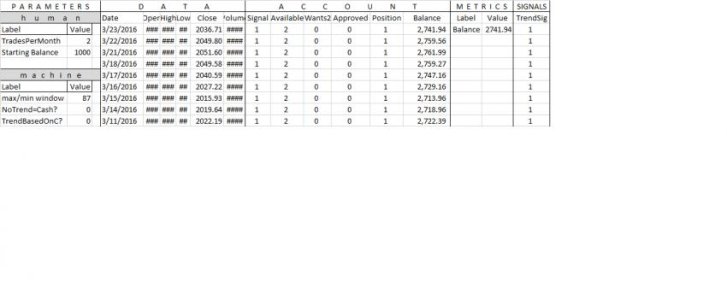Better post this before I forget. Still just casually and quickly testing things.
Forgot to mention that I had the Solver algo set to shut down after 10 minutes without any improvement. I can probably achieve better results using a longer setting. But I usually use a shorter setting for comparing systems etc. I did push it up to 20 minutes though.
As I posted, the trend system clocked in at $2700 with $1000 initial. I added a delay feature to it.
The delay parameter allowed the algo to choose a number of delays to delay issuing the signal, after the actual signal was generated. Reasoning:
Many times, when a higher high occurs, there is first a pullback, prior to a continuation of the upward thrust. With this change, there was a little improvement...to 3100 I believe.
__________________
There are a few traditional
indicators I feel have promise (non lagging indicators): Stop and Reverse, Breakouts, and Channel fades. The others may work under the right conditions, not sure. I'll test some here.
I coded the SAR, it did better than the Trend alone: 3900. That equates to doubling your money twice over 16 years. Respectable I guess. I combined the SAR with the Trend and bumped the results up to 4100.
The SAR works by setting a stop-loss that the algo determines, and setting a "profit-reverse," also determined by the algo.
I primed it by making it go long on the first day of my historical data, sometime in Oct, 1999. Then, it sets the stop-loss price and the profit-reverse price, and signal for all subsequent dates--the backtest. I also added a "
time reverse" parameter to the algo.
The "time reverse" forces the system to reverse position after a certain number of days as determined by the also.
The system will reverse, then reset the stop-loss and reverse values if the stop-loss, profit-reverse, or time-reverse targets are hit.
The SAR along with the TREND together did 4600 (after I bumped the algo run time without improvements to 20 minutes). Keep in mind, this system is only going LONG and doesn't include G- or F-Fund trades.
_____________
Prior to doing the above, I did test a SMA crossover with another SMA and that configuration did poorly.
Next, I will test a SMA crossover with the underlying where the SMA parameter is determined dynamically by a custom volatility indicator I'll create. The algo will figure out all of the parameter settings for us, of course.
_____________
I've tested a lot of these things before, not all of them though. None of them came close to my pattern matching systems, which I currently use and develop. Again, I've always been curious as to how these non-pattern systems would perform if I built them now...knowing what I know now.
JTH motivated me, so here we are.



